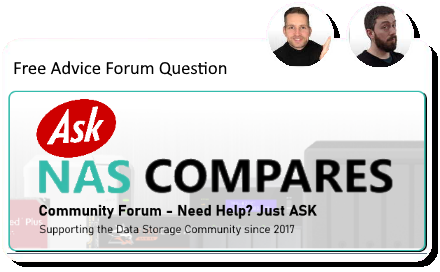09-16-2025, 09:39 AM
For starting configuration, 4 × 16TB drives in SHR2 is a very safe balance. That setup will give you around 32TB usable, with protection against two drive failures. Since your data is business-critical and you’re planning to back up to Backblaze as well, SHR2 is a smart choice. It’s always easier to relax protection later than to wish you had more redundancy after a failure.
As for whether to fill all the bays, you don’t need to do that up front. Drives do wear over time even if they aren’t fully used, and there’s no benefit in having empty capacity just sitting in RAID. Starting with 4 drives is perfectly fine. Synology lets you expand the pool later by adding more drives, and SHR makes that process flexible. You’ll only rebuild when you add, so it’s straightforward to scale as your storage needs grow.
If you wanted to maximize space efficiency early on, SHR1 would give you around 48TB usable from the same 4 × 16TB drives. But given the cost of your projects and the importance of avoiding downtime, SHR2 is the safer call. The fact you’ll also have cloud backup means you’ll have three layers: live NAS, redundancy with SHR2, and off-site with Backblaze. That’s a strong long-term plan.
So I’d recommend: start with 4 × 16TB in SHR2, scale by adding more drives only as you need them, and keep your Backblaze backup active. That will give you a reliable, future-proof setup without burning through drives unnecessarily.
As for whether to fill all the bays, you don’t need to do that up front. Drives do wear over time even if they aren’t fully used, and there’s no benefit in having empty capacity just sitting in RAID. Starting with 4 drives is perfectly fine. Synology lets you expand the pool later by adding more drives, and SHR makes that process flexible. You’ll only rebuild when you add, so it’s straightforward to scale as your storage needs grow.
If you wanted to maximize space efficiency early on, SHR1 would give you around 48TB usable from the same 4 × 16TB drives. But given the cost of your projects and the importance of avoiding downtime, SHR2 is the safer call. The fact you’ll also have cloud backup means you’ll have three layers: live NAS, redundancy with SHR2, and off-site with Backblaze. That’s a strong long-term plan.
So I’d recommend: start with 4 × 16TB in SHR2, scale by adding more drives only as you need them, and keep your Backblaze backup active. That will give you a reliable, future-proof setup without burning through drives unnecessarily.





